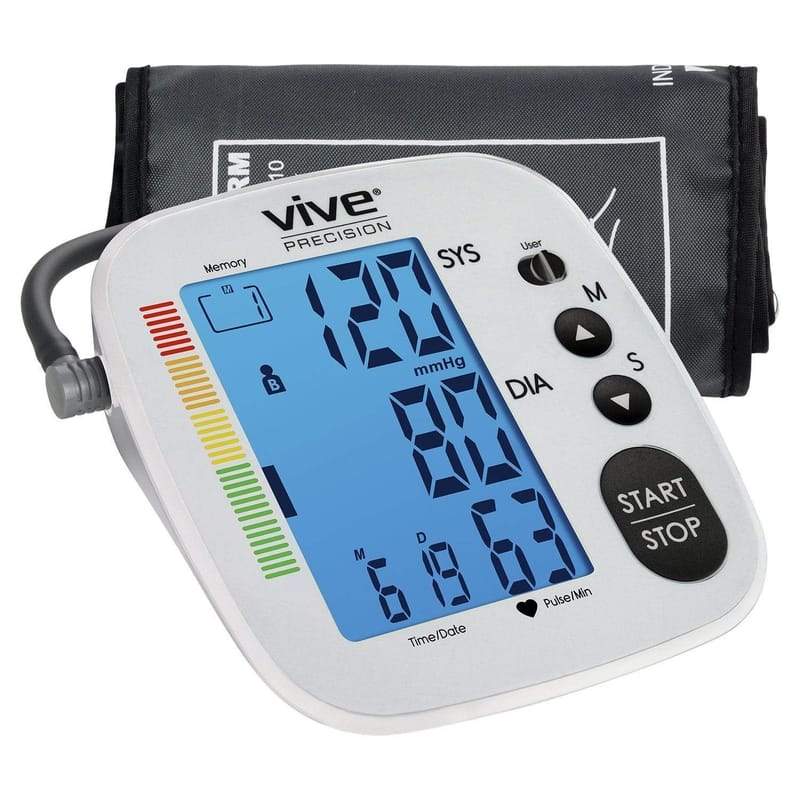A Blood Pressure Monitor is a medical device used to measure blood pressure, helping individuals track and manage hypertension or other cardiovascular conditions. These devices are widely used in clinical settings and at home for regular monitoring.
Types of Blood Pressure Monitors:
- Manual Monitors:
- Aneroid Monitors: Require a stethoscope to listen to blood flow and manually read blood pressure from a gauge. Typically used by healthcare professionals.
- Mercury Sphygmomanometers: Considered the gold standard but less common due to mercury restrictions.
- Digital Monitors:
- Upper Arm Monitors: Measure blood pressure via a cuff placed around the upper arm. They are highly accurate and widely recommended.
- Wrist Monitors: Compact and portable, worn on the wrist, though slightly less accurate than arm models.
- Finger Monitors: Convenient but generally less reliable and not commonly used for clinical purposes.
- Ambulatory Blood Pressure Monitors (ABPM):
- Worn throughout the day to provide continuous readings, often used for diagnostic purposes.
- Smart Blood Pressure Monitors:
- Integrated with apps or devices for tracking and sharing data.
- Features Bluetooth or Wi-Fi connectivity.
How It Works:
- Preparation:
- Rest for 5 minutes in a quiet environment.
- Sit upright with your back supported and feet flat on the ground.
- Place the cuff on your bare upper arm or wrist at heart level.
- Inflation and Measurement:
- The cuff inflates to restrict blood flow and then gradually deflates.
- Sensors detect blood flow and calculate systolic (top number) and diastolic (bottom number) pressure.
- Reading and Recording:
- Digital monitors display results on a screen within seconds.
- Advanced models may save readings for tracking trends over time.
Benefits:
- Regular Monitoring:
- Helps detect high or low blood pressure trends early.
- Supports ongoing management of hypertension or hypotension.
- Convenience:
- Enables at-home monitoring, reducing the need for frequent clinic visits.
- Portable options allow for on-the-go tracking.
- Data Tracking:
- Many devices store readings, and smart models sync data to apps for better analysis.
- Improved Health Outcomes:
- Regular monitoring aids in better medication adherence and lifestyle adjustments.
Key Features to Consider:
- Accuracy:
- Look for clinically validated models.
- Ensure the cuff fits properly, as incorrect sizing affects accuracy.
- Ease of Use:
- Automatic inflation and one-touch operation for simplicity.
- Large, clear display for easy reading.
- Memory Storage:
- Stores multiple readings for tracking over time.
- Some models allow multiple user profiles.
- Portability:
- Compact designs for travel.
- Battery or rechargeable options.
- Connectivity:
- Advanced models integrate with smartphones or smartwatches.
Tips for Accurate Readings:
- Correct Positioning:
- Ensure the cuff is snug but not too tight.
- Keep the arm supported at heart level.
- Consistency:
- Measure at the same time each day for reliable comparisons.
- Avoid caffeine, smoking, or exercise at least 30 minutes before measuring.
- Multiple Measurements:
- Take 2–3 readings and average the results.
Maintenance and Care:
- Clean the Cuff:
- Wipe with a damp cloth and let it air dry.
- Replace Batteries:
- Regularly check battery levels to avoid interruptions.
- Calibration:
- Periodically have the device checked for accuracy, especially for long-term use.
Blood pressure monitors empower individuals to take control of their cardiovascular health. Consult with a healthcare provider to select the most suitable monitor and to interpret readings effectively.









Reviews
There are no reviews yet.